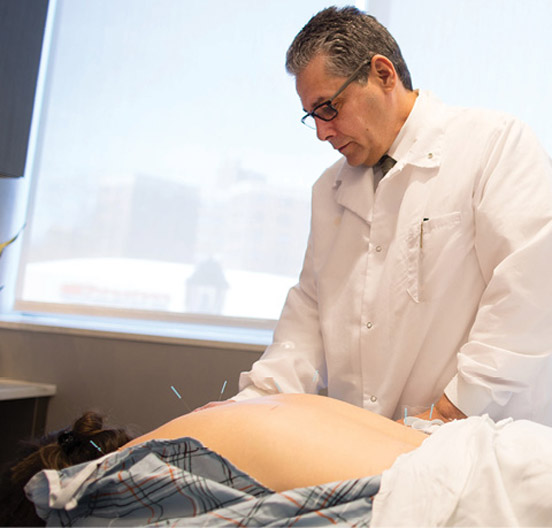A U.S. government study found that 53.1% of office-based physicians in the U.S. recommend at least one complementary, also known as alternative, health approach for their patients.
The study was published in November by a unit of the National Institutes of Health, the National Center for Complementary and Integrative Health and the National Center for Health Statistics. It appeared in “The Journal of Alternative and Complementary Medicine.”

Dr. Eugenio Jimenez de Castro performs acupuncture on a patient.
Massage therapy was the most commonly recommended complementary health approach and was offered by 30.4% of the doctors, followed by chiropractic/osteopathic manipulation at 27.1%, herbs/nonvitamin supplements at 26.5%, yoga at 25.6% and acupuncture at 22.4%.
Alternative medicine also has been finding acceptance in hospitals and White Plains Hospital is one of them.
Among the specialties and services being offered are acupuncture, yoga, health and nutrition counseling, psychosocial services such as art therapy and music programs, pet therapy, massage and guided meditation classes. Many of the alternative programs the hospital offers are free. When there are costs involved, many insurance plans provide coverage.
Dr. Michael J. Palumbo, the hospital’s executive vice president and chief medical officer, oversees all medical services, clinical quality, safety and patient privacy. He told the Business Journal that the hospital’s acceptance of alternative medicine originally was focused on helping patients at the hospital’s Center for Cancer Care. He said when they were designing a new building for the center they were thinking outside of the usual hospital building box.
“These patients end up spending a large percentage of their time in this building between the doctors”™ appointments and the treatments, so we really wanted to create an environment that was warm and supportive and designed in a humanistic way,” Palumbo said. “Some of the alternative programs that we put in place were an outgrowth of that.”
Palumbo said there is a healthy cafe, meetings of support groups, a knitting club, classes conducted by an art therapist in the lobby and, on some days, live music.
“We started to think about the ways in which we could start to tap into the various alternative medicine modalities,” Palumbo said.
He added that there is objective clinical evidence showing that some of them help with symptom control and, depending upon the disease, are therapeutic.
“Many of them have beneficial effects when it comes to emotional stress and reducing depression and anxiety,” he said. “We wanted to start to introduce these as part of the embracing of the whole patient.”
Palumbo said the first alternative element for which he personally advocated was making acupuncture therapy available at the cancer center.
“We thus far have not extended that to the inpatient setting but it is something that I am working toward. Acupuncture has been shown to be very helpful with chemotherapy-induced nausea. It’s very helpful for reducing anxiety and promoting relaxation and it also has been shown to be helpful for some of the toxicity that the nerves can experience as a side effect of chemotherapy, what we call neuropathy,” Palumbo said.
The acupuncturist is considered to be on the hospital’s staff because he provides services there but is not a hospital employee.
“We have lots of doctors in the community, for example, who aren’t employed by the hospital but have to be medical staff members and go through a process of verifying their credentials and their privileges,” Palumbo explained. “We also have a program that we call Healing Touch, which is technically a massage technique but is something that our department of nursing runs and they also use evidence-based techniques around acupressure, as well as certain elements of Reiki massage as well as certain elements of Swedish massage.”
The program is offered for both inpatients and outpatients.
“It’s been shown that these types of therapies are very effective at reducing pain in particular as a symptom. If patients are offered this, part of it is not only rendering the technique but teaching the patients how to do it themselves to a certain extent. These patients use far less pain medication because their symptoms are better controlled,” he said.
Palumbo said an important part of what the medical community has learned over the past 10 years or so as the opioid crisis has exploded is that physicians who were trained 20 or 30 years ago did not get accurate information about how the painkillers could impact patients.
“We were really trained that people who were in pain did not become addicted and that, therefore, you should not worry about that. You should prescribe generously,” Palumbo said. “We’ve subsequently learned that science indicates otherwise and that most people are vulnerable to addiction if they’re exposed and that even minimal amounts can be dangerous. So, we should, of course, still make sure we use the more appropriate (medication dose) but we should be more judicious about alternative techniques and trying to minimize the risk of opioid addiction.”
Aroma therapy is another technique that has been helpful for patients. Nurses at the hospital completed a study looking at postoperative nausea incidents after anesthesia and the impact of using peppermint inhalation.
“Their results were so impressive they actually were invited to a national conference to present the information, so that’s become a standard part of what we do after surgery now,” Palumbo said.
He said pet therapy is one of the longest-running and most popular programs, having started more than 15 years ago. Palumbo noted that it is popular at other hospitals, too, and that the dogs are very well trained and patients often tell him how appreciative they are of the visits.
“We continue to be open-minded looking for new opportunities, asking for feedback from our patients and hopefully continuing to develop this holistic approach,” he said.



















